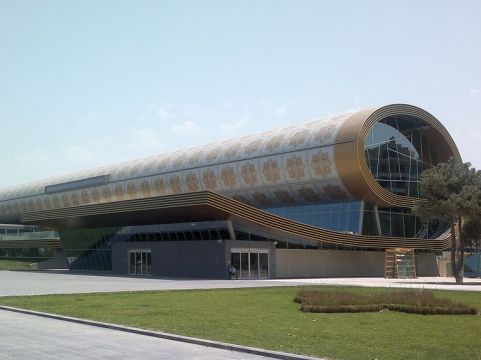Unique carpet museum to open in Baku by year-end

By Nigar Orujova, Azernews Staff Writer
A new carpet museum designed in the form of a rolled carpet will open in the Baku seaside park (boulevard) by the end of 2012.
The Azerbaijan Ministry of Culture and Tourism said the four-storied building will be the first museum complex in Azerbaijan.
Carpet-weaving art is one of the ancient crafts in Azerbaijan. For centuries the Land of Fire has been famous for its unique carpets, which nowadays are exhibited in many world museums - in the Louvre in Paris, in the Hermitage in Saint-Petersburg, in the Victoria and Albert in London, in the Textile in Washington, in the Topkapi in Istanbul, and others.
In November 2010 the Azerbaijani carpet was proclaimed a Masterpiece of Intangible Heritage by UNESCO.
Azerbaijani carpets are mentioned in the well-known Oguz Turkic epos book of Dede Korkut. The tradition of carpet-weaving becomes popular during the Safavid dynasty`s rule. A masterpiece of Azerbaijani carpet weavers dating back to that period is currently preserved in the Louvre.
Azerbaijani rugs were cited in the records of European travelers, such as the Flemish missionary Guillaume de Rubrouck and the Venetian explorer Marco Polo, and featured in the paintings of European artists, with Hans Holden the Younger and Hans Mumbling being among them.
In Azerbaijan, this craft has developed through centuries and reached its perfection nowadays.
This craft was highly connected to the daily life of the population, traditional song performances during the Novruz holiday, and the local New Year, with carpets being used as a home decoration and part of furniture; special carpets are believed to be used for medical treatment.
Wonderful Azerbaijani carpets are represented in two types: piled and pileless. Pileless carpets are of eight kinds, the most famous of which are Palas, Dzhejim, Zili, and Sumakh.
About 600 varieties of carpet ornaments exist at present. The most popular of them is the well-known Buta ornament.
A particular design was popular in one or another region depending on carpet weaving techniques in different parts of the country.
There are several schools of carpet weaving in the country, which are distinguished by patterns, color palette and composition of carpets, such as Guba-Shirvan, Ganja-Gazakh, Karabakh and Tabriz carpet-making schools.
One of the most remarkable features of the Azerbaijani carpet is natural dye used to color them, which protects carpets from erosion of wool fibers. Hand-made carpet production guarantees the uniqueness of every carpet.
Except the general history of the craft itself, each and every carpet has its own history. The tradition of carpet-weaving developed from the villages, where women devolved their knowledge from one generation to another and saved this charming experience of the population of the magic Azerbaijan country.
Carpets are the most popular and practical element of everyday life in Azerbaijan - they are still the best present for a newborn child, for a wedding; they are also used for prayers and mourning rituals.
Even if it`s your first visit to Azerbaijan you cannot but admit that carpets are everywhere in this colorful country, covering floors and walls of both contemporary houses and old buildings. And if you want to be part of this old-established tradition, you have to buy an Azerbaijani carpet.
The Azerbaijan State Carpet Museum, the first carpet museum in the world, was founded in 1967 in Baku. First it was located in the Juma Mosque in the Old City, and then moved to the former Lenin Museum in 1992.
The carpet museum is named after well-known Azerbaijani scientist Latif Karimov, who is the founder of the carpet study and carpet history in Azerbaijan.
There are a number of scholars and art experts who study the history of Azerbaijani art nowadays. One of them is Roya Tagieva, the museum`s director, who popularizes Azerbaijani carpets all over the world.
Here we are to serve you with news right now. It does not cost much, but worth your attention.
Choose to support open, independent, quality journalism and subscribe on a monthly basis.
By subscribing to our online newspaper, you can have full digital access to all news, analysis, and much more.
You can also follow AzerNEWS on Twitter @AzerNewsAz or Facebook @AzerNewsNewspaper
Thank you!
